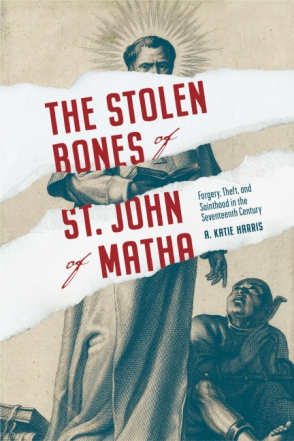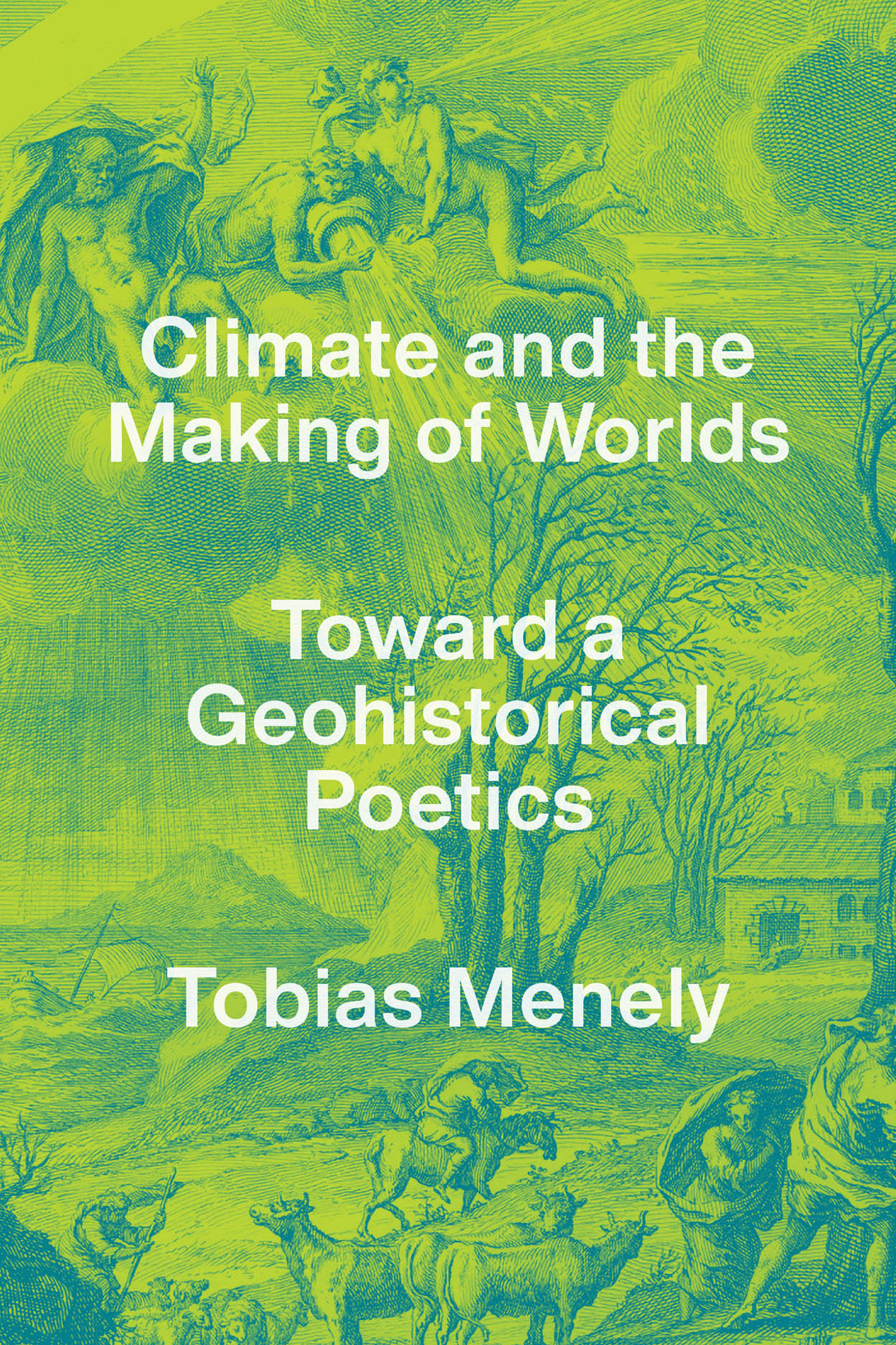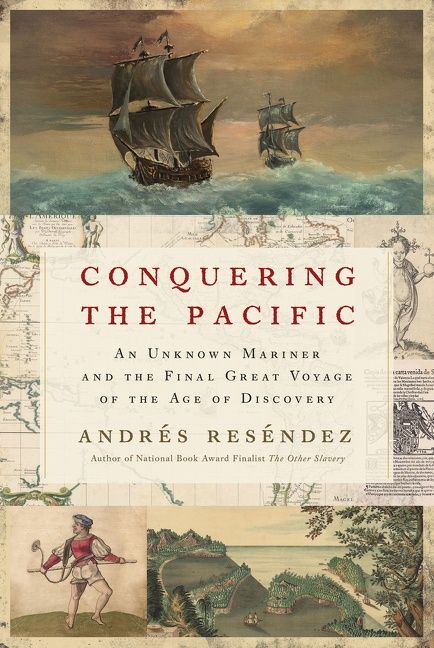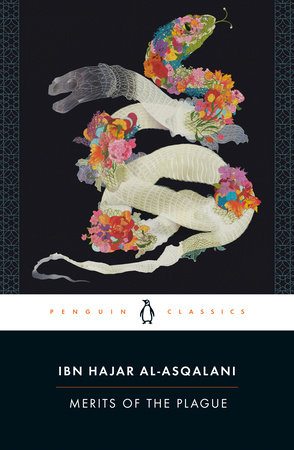Featured Books at "Worlds Encompassed: Premodern Making and Mingling" Event 5/2/2024

This site profiles the books by campus authors that will be showcased at the "Worlds Encompassed: Premodern Making and Mingling" event to held in Peter J. Shields Library May 2nd, 2024. This event features new work on the marvels of the premodern world through expert talks, graduate student posters, and a guided tour of the library’s exhibit of rare books and materials. These recent works are avaiable through the UC Davis Library.
This event was co-sponsored by the UC Davis Library and the Medieval and Early Modern Studies Program (MEMS), with the generous support of MEMS affiliate departments: Classics, East Asian Languages and Cultures, English, French and Italian, German and Russian, History, ME/SA, Music, Religious Studies, and Theatre and Dance.
The following book descriptions were taken from the publishers' descriptions of these books.
Gina Bloom, Evan Buswell, Colin Milburn, and Nick Toothman
Experimenting with Shakespeare
EMC Imprint (Santa Barbara), 2024.

Experimenting with Shakespeare contends that play is a method of knowledge-making and that Shakespearean theater can be a generative model for laboratory life. The book reflects on the history of the ModLab at UC Davis, an experimental media space bringing together computer scientists, historians of science, theorists of performance, literary scholars, and media designers. Gina Bloom, Evan Buswell, Colin Milburn, and Nick Toothman describe how the lab’s improvisatory methods led to the development of Play the Knave, an award-winning video game that allows players to perform selections of Shakespeare’s plays in a variety of virtual environments. Experimenting with Shakespeare shows how video games can become instruments for exploring the edges of disciplines and argues for the centrality of play to collaborative work in the sciences, the arts, and the digital humanities.

Katharine Burnett
Shaping Chinese Art History: Pang Yuanji and His Painting Collection
Cambria Press, 2020.
Although studies of collectors and collections are on the rise, the collector in China with not only the largest number of high-quality antique paintings but also the most comprehensive and scholarly record of his collection has largely been left unexamined. Pang Yuanji (1864–1949) is that collector, and this book addresses the situation. Analysis of Pang’s collection reveals not only his personal taste but also how his taste was an expression of the Qing dynasty canon. As such, Pang’s taste is shown to be standard for the time, and then the standard upheld in new collections abroad. When Pang’s renowned collection became a source for object acquisition by U.S. collectors and museums new to Chinese art (especially Charles Lang Freer and the Freer Gallery), this taste was inevitably absorbed and disseminated through museum exhibitions and scholarly research and teaching. The inadvertent effect of this was that the new field of Chinese art history developed around the Qing canon, a canon that survived well into the latter half of the twentieth century. Knowing about Pang Yuanji and his collection thus helps readers better understand some of the forces at work in shaping Chinese art history today.
This is the first study that takes the innovative and unique approach to collection analysis by quantifying Pang’s collection and comparing it to a selection of contemporaneous private collectors. In doing so, it shows how their tastes and interests were all shaped by the same Qing canon. More broadly, it explains that Pang did not merely absorb this canon, but then also purposefully and systematically used it and his collection to protect China’s traditions into an uncertain future.
Moving from collection analysis to an examination of Pang’s life, the book replaces Pang’s commonplace yet reductionist identity as merchant-collector with a more nuanced understanding of his identity as social transformer. Pang’s role as a modernist with a nationalist agenda becomes evident in the technological advancements and new forms of banking that he brought to his businesses, and the science-based medicine and techniques that he instituted in his hospitals. Through these, his philanthropy and civic leadership, and his renowned collection, he became a respected social and cultural figure in and outside of China. This book thus assesses his impact in his time and on the field of art history. Shaping Chinese Art History: Pang Yuanji and His Painting Collection is an important book for readers of Asian studies, art history, and museum and collections studies, and historiography.

Frances Dolan
Digging the Past: How and Why to Imagine Seventeenth-Century Agriculture
University of Pennsylvania Press, 2020.
A detailed study of seventeenth century farming practices and their relevance for today. We are today grappling with the consequences of disastrous changes in our farming and food systems. While the problems we face have reached a crisis point, their roots are deep. Even in the seventeenth century, Frances E. Dolan contends, some writers and thinkers voiced their reservations, both moral and environmental, about a philosophy of improvement that rationalized massive changes in land use, farming methods, and food production. Despite these reservations, the seventeenth century was a watershed in the formation of practices that would lead toward the industrialization of agriculture. But it was also a period of robust and inventive experimentation in what we now think of as alternative agriculture. This book approaches the seventeenth century, in its failed proposals and successful ventures, as a resource for imagining the future of agriculture in fruitful ways. It invites both specialists and non-specialists to see and appreciate the period from the ground up.
Building on and connecting histories of food and work, literary criticism of the pastoral and georgic, histories of elite and vernacular science, and histories of reading and writing practices, among other areas of inquiry, Digging the Past offers fine-grained case studies of projects heralded as innovations both in the seventeenth century and in our own time: composting and soil amendment, local food, natural wine, and hedgerows. Dolan analyzes the stories seventeenth-century writers told one another in letters, diaries, and notebooks, in huge botanical catalogs and flimsy pamphlets, in plays, poems, and how-to guides, in adages and epics. She digs deeply to assess precisely how and with what effect key terms, figurations, and stories galvanized early modern imaginations and reappear, often unrecognized, on the websites and in the tour scripts of farms and vineyards today.

Ihara Saikaku’s This Scheming World: Classic Tales of Desire, Deception and Greed in Old Japan
(revised, with new introduction by David Gundry)
Tuttle Publishing, 2023
The culmination of Saikaku's perceptive genius, the 20 short stories within This Scheming World recount raucous events and incidents on New Year's Eve as everyone tries to settle their debts for the year, as is the New Year's custom. Crafty money lenders attempt to collect their money from equally crafty debtors, and Saikaku portrays his characters with so lifelike a touch that, even though three centuries have passed since his time, it seems as if they were our contemporaries.The new Introduction by Saikaku expert David J. Gundry explains how and why this entertaining work still resonates with modern readers today.

Lu Rong (Translation by Mark Halperin)
A Ming Confucian's World: Selections from Miscellaneous Records from the Bean Garden
University of Washington Press, 2022.
A forgotten century marks the years between the Ming dynasty's (1368–1644) turbulent founding and its sixteenth-century age of exploration and economic transformation. In this period of social stability, retired Confucian scholar-official Lu Rong (1436-1494) chronicled his observations of Chinese society in Miscellaneous Records from the Bean Garden (Shuyuan zaji). Openly expressing his admirations and venting his frustrations, Lu provides a window into the quotidian that sets Bean Garden apart from other works of the biji genre of "informal notes."
Mark Halperin organizes a translated selection of Lu's records to create a panorama of Ming life. A man of unusual curiosity, Lu describes multiple social classes, ethnicities, and locales in his accounts of political intrigues, farming techniques, religious practices, etiquette, crime, and family life. Centuries after their composition, Lu's words continue to provide a richly textured portrait of China on the cusp of the early modern era.

Katie Harris
The Stolen Bones of St. John of Matha: Forgery, Theft, and Sainthood in the Seventeenth Century
Penn State University Press, 2023.
On the night of March 18, 1655, two Spanish friars broke into a church to steal the bones of the founder of their religious institution, the Order of the Most Holy Trinity. This book investigates this little-known incident of relic theft and the lengthy legal case that followed, together with the larger questions that surround the remains of saints in seventeenth-century Catholic Europe.
Drawing on a wealth of manuscript and print sources from the era, A. Katie Harris uses the case of St. John of Matha’s stolen remains to explore the roles played by saints’ relics, the anxieties invested in them, their cultural meanings, and the changing modes of thought with which early modern Catholics approached them. While in theory a relic’s authenticity and identity might be proved by supernatural evidence, in practice early modern Church authorities often reached for proofs grounded in the material, human world—preferences that were representative of the standardizing and streamlining of sixteenth- and seventeenth-century saint-making. Harris examines how Matha’s advocates deployed material and documentary proofs, locating them within a framework of Scholastic concepts of individuation, identity, change, and persistence, and applying moral certainty to accommodate the inherent uncertainty of human evidence and relic knowledge.
Engaging and accessible, The Stolen Bones of St. John of Matha raises an array of important questions surrounding relic identity and authenticity in seventeenth-century Europe. It will be of interest to students, scholars, and casual readers interested in European history, religious history, material culture, and Renaissance studies.

Ovid (Edited and translated by Ralph Hexter, also edited and translated with Laura Pfuntner and Justin Haynes)
Appendix Ovidiana: Latin Poems Ascribed to Ovid in the Middle Ages
Harvard University Press 2020.
Appendix Ovidiana: Latin Poems Ascribed to Ovid in the Middle Ages brings together virtually all surviving Latin poems that were ascribed to the Roman poet Ovid (43 BCE – 17 CE) between roughly 500 and 1500. The majority were composed in the Middle Ages, though some are classical in origin. While current scholarly consensus designates them as pseudo-Ovidian, whether the aim of their actual authors was deception or homage, the poems were regarded as Ovid’s in the medieval period, reflecting medieval understandings of the greatly admired classical poet and developing his legacy, at times in surprising – and at times disturbing – ways.
The medieval Ovid who emerges from the Appendix is if anything more dazzling in his variety than the original. He is more often a naturalist than a mythographer, recounting in a number of miniatures the adventures of insects and animals. The original Ovid presented himself as lover and instructor in the art of love, so it is no surprise that many of the pseudo-Ovidiana are explicitly erotic. It is a sad truth that many are misogynistic, some grossly so: many of the spaces in medieval Europe that created and consumed Latin poetry were exclusive male preserves. The longest of the poems, “On the Old Woman” (De vetula), is an invented autobiography of an Ovid who, after erotic misadventures involving both slapstick and heartbreak, arrives at a vision of the birth, death, and resurrection of Christ. The poem was massively influential. Its lengthy discussions of medieval board games, mathematics and astronomy make it extraordinarily hard to understand, and the English translation here – fresh English renderings accompany all the texts – is the first in any modern language. While the actual authors of these poems are unknown, the volume advances Justin Haynes’ hypothesis that the reason Roger Bacon (1220-1292) shows such detailed knowledge of De vetula is that in fact he wrote it.

Tobias Menely
Climate and the Making of Worlds: Toward a Geohistorical Poetics
University of Chicago Press. 2021
In this book, Tobias Menely develops a materialist ecocriticism, tracking the imprint of the planetary across a long literary history of poetic rewritings and critical readings which continually engage with the climate as a condition of human world making. Menely’s central archive is English poetry written between John Milton’s Paradise Lost (1667) and Charlotte Smith’s “Beachy Head” (1807)—a momentous century and a half during which Britain, emerging from a crisis intensified by the Little Ice Age, established the largest empire in world history and instigated the Industrial Revolution. Incorporating new sciences into ancient literary genres, these ambitious poems aspired to encompass what the eighteenth-century author James Thomson called the “system . . . entire.” Thus they offer a unique record of geohistory, Britain’s epochal transition from an agrarian society, buffeted by climate shocks, to a modern coal-powered nation. Climate and the Making of Worlds is a bracing and sophisticated contribution to ecocriticism, the energy humanities, and the prehistory of the Anthropocene.

Sal Nicolazzo
Vagrant Figures: Law, Literature, and the Origins of the Police
Yale University Press, 2021.
In this innovative book demonstrating the important role of eighteenth-century literary treatments of policing and vagrancy, Nicolazzo offers a prehistory of police legitimacy in a period that predates the establishment of the modern police force. They argue that narrative, textual, and rhetorical practices shaped not only police and legal activity of the period, but also public conceptions of police power. Their extensive research delves into law and literature on both sides of the Atlantic, tracking the centrality of vagrancy in establishing police power as a form of sovereignty crucial to settler colonialism, slavery, and racial capitalism. The first book in several generations to address policing and vagrancy in the eighteenth century, and the first in the field to center race and empire in its account of literary vagrancy, Nicolazzo’s work is a significant contribution to the field of eighteenth-century literary and cultural studies.

Andrés Reséndez
Conquering the Pacific: An Unknown Mariner and the Final Great Voyage of the Age of Discovery
Houghton Mifflin Harcourt, 2021.
The story of an uncovered voyage as colorful and momentous as any on record for the Age of Discovery-and of the Black mariner whose stunning accomplishment has been until now lost to history It began with a secret mission, no expenses spared. Spain, plotting to break Portugal's monopoly trade with the fabled Orient, set sail from a hidden Mexican port to cross the Pacific--and then, critically, to attempt the never-before-accomplished return, the vuelta. Four ships set out from Navidad, each one carrying a dream team of navigators. The smallest ship, guided by seaman Lope Martín, a mulatto who had risen through the ranks to become one of the most qualified pilots of the era, soon pulled far ahead and became mysteriously lost from the fleet. It was the beginning of a voyage of epic scope, featuring mutiny, murderous encounters with Pacific islanders, astonishing physical hardships-and at last a triumphant return to the New World. But the pilot of the fleet's flagship, the Augustine friar mariner Andrés de Urdaneta, later caught up with Martín to achieve the vuelta as well. It was he who now basked in glory, while Lope Martín was secretly sentenced to be hanged by the Spanish crown as repayment for his services. Acclaimed historian Andrés Reséndez, through brilliant scholarship and riveting storytelling-including an astonishing outcome for the resilient Lope Martín--sets the record straight.

Brenda Deen Schildgen
Dante and Violence: Domestic, Civic, Cosmic
University of Notre Dame Press, 2021.
This study explores how Dante represents violence in the Comedy and reveals the connection between contemporary private and public violence and civic and canon law violations. The book Helen and Howard Marrero Prize in Italian Literature in 2022.
Although a number of articles have addressed particular aspects of violence in discrete parts of Dante’s oeuvre, a systematic treatment of violence in the Commedia is lacking. This ambitious overview of violence in Dante’s literary works and his world examines cases of violence in the domestic, communal, and cosmic spheres while taking into account medieval legal approaches to rights and human freedom that resonate with the economy of justice developed in the Commedia. Exploring medieval concerns with violence both in the home and in just war theory, as well as the Christian theology of the Incarnation and Redemption, Brenda Deen Schildgen examines violence in connection to the natural rights theory expounded by canon lawyers beginning in the twelfth century. Partially due to the increased attention to its Greco-Roman cultural legacy, the twelfth-century Renaissance produced a number of startling intellectual developments, including the emergence of codified canon law and a renewed interest in civil law based on Justinian’s sixth-century Corpus juris civilis. Schildgen argues that, in addition to “divine justice,” Dante explores how the human system of justice, as exemplified in both canon and civil law and based on natural law and legal concepts of human freedom, was consistently violated in the society of his era. At the same time, the redemptive violence of the Crucifixion, understood by Dante as the free act of God in choosing the Incarnation and death on the cross, provides the model for self-sacrifice for the communal good. This study, primarily focused on Dante’s representation of his contemporary reality, demonstrates that the punishments and rewards in Dante’s heaven and hell, while ostensibly a staging of his vision of eternal justice, may in fact be a direct appeal to his readers to recognize the crimes that pervade their own world.
Kathy Stuart
Suicide by Proxy in Early Modern Germany: Crime, Sin and Salvation
Palgrave Macmillan, 2023.
Suicide by Proxy became a major societal problem after 1650. Suicidal people committed capital crimes with the explicit goal of “earning” their executions, as a short-cut to their salvation. Desiring to die repentantly at the hands of divinely-instituted government, perpetrators hoped to escape eternal damnation that befell direct suicides. Kathy Stuart shows how this crime emerged as an unintended consequence of aggressive social disciplining campaigns by confessional states. Paradoxically, suicide by proxy exposed the limits of early modern state power, as governments struggled unsuccessfully to suppress the tactic. Some perpetrators committed arson or blasphemy, or confessed to long-past crimes, usually infanticide, or bestiality. Most frequently, however, they murdered young children, believing that their innocent victims would also enter paradise. The crime had cross-confessional appeal, as illustrated in case studies of Lutheran Hamburg and Catholic Vienna.
Ibn Hajar al-Asqalani (Edited and tranlated by Mairaj Syed and Joel Blecher)
Merits of the Plague
Penguin Random House, 2023.
Six hundred years ago, the author of this landmark work of history and religious thought—an esteemed judge, poet, and scholar in Cairo—survived the bubonic plague, which took the lives of three of his children, not to mention tens of millions of others throughout the medieval world. Holding up an eerie mirror to our own time, he reflects on the origins of plagues—from those of the Prophet Muhammad’s era to the Black Death of his own—and what it means that such catastrophes could have been willed by God, while also chronicling the fear, isolation, scapegoating, economic tumult, political failures, and crises of faith that he lived through. But in considering the meaning of suffering and mass death, he also offers a message of radical hope. Weaving together accounts of evil jinn, religious stories, medical manuals, death-count registers, poetry, and the author’s personal anecdotes, Merits of the Plague is a profound reminder that with tragedy comes one of the noblest expressions of our humanity: the practice of compassion, patience, and care for those around us.

Colin Webster
Tools and the Organism: Technology and the Body in Ancient Greek and Roman Medicine
University of Chicago Press, 2023.
The first book to show how the concept of bodily organs emerged and how ancient tools influenced conceptualizations of human anatomy and its operations.
Medicine is itself a type of technology, involving therapeutic tools and substances, and so one can write the history of medicine as the application of different technologies to the human body. In Tools and the Organism, Colin Webster argues that, throughout antiquity, these tools were crucial to broader theoretical shifts. Notions changed about what type of object a body is, what substances constitute its essential nature, and how its parts interact. By following these changes and taking the question of technology into the heart of Greek and Roman medicine, Webster reveals how the body was first conceptualized as an “organism”—a functional object whose inner parts were tools, or organa, that each completed certain vital tasks. He also shows how different medical tools created different bodies.
Webster’s approach provides both an overarching survey of the ways that technologies impacted notions of corporeality and corporeal behaviors and, at the same time, stays attentive to the specific material details of ancient tools and how they informed assumptions about somatic structures, substances, and inner processes. For example, by turning to developments in water-delivery technologies and pneumatic tools, we see how these changing material realities altered theories of the vascular system and respiration across Classical antiquity. Tools and the Organism makes the compelling case for why telling the history of ancient Greco-Roman medical theories, from the Hippocratics to Galen, should pay close attention to the question of technology.
Library Resources for Medieval and Early Modern Studies
- Medieval and Early Modern Studies
-
History of Africa and the Middle East
by David Michalski Last Updated Dec 2, 2024 185 views this year
- History of Asia
-
History of Europe
by David Michalski Last Updated Dec 2, 2024 139 views this year
- Native American Studies
-
Anthropology
by David Michalski Last Updated Nov 7, 2024 136 views this year
- Art, Architecture, Art History and Design

